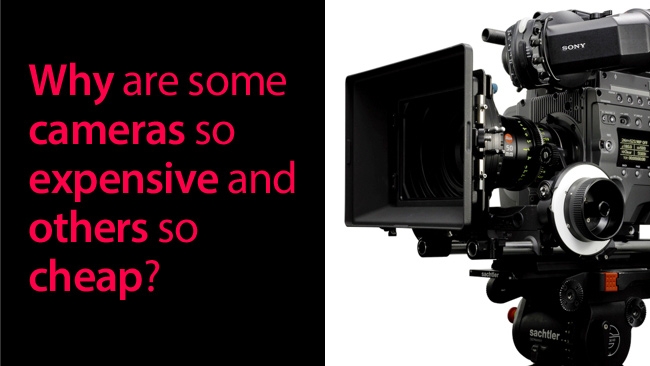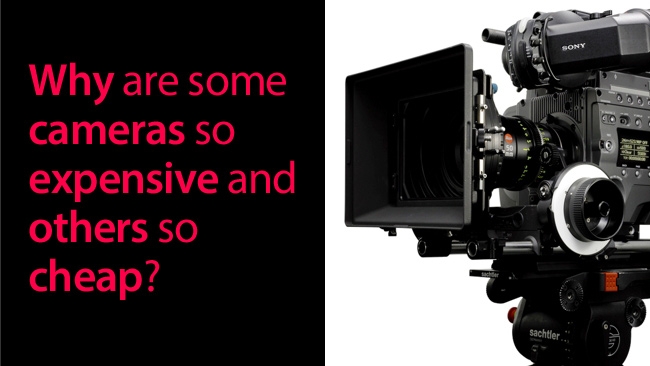
 F65
F65
RedShark Replay: Why is there such a huge difference in the price of some cameras, which might both be supposedly "Cinema Quality"?
Have you ever sat in one of those bulkhead seats on an airliner? Do you know the ones I mean? They're just behind the dividing panels between cattle class and business class. It's where they normally put mothers and small babies, so, if you do manage to nab one of these sought-after seats that come with enormous free extra legroom, the downside is that when you want to sleep, the adjacent babies will be wailing in your ear.
But if they are, there's plenty to occupy you. That's because everything you know about an ordinary aircraft seat is different when you're stationed behind a bulkhead. For a start, there's no video screen to be seen. How could there be? There's no seat in front to support one.
Some time after everyone else has settled into their in-flight movie, you may be lucky enough to discover your screen is hidden away in a slot behind your seat. You have to press a button to release it, and then pull it out, turning it through ninety degrees, and then arranging it in front of you so that you can actually see it.
And this is just the start of your troubles, because there's no seat-back tray, either. This essential piece of kit for a comfortable flight is even more hidden. Normally, it's below the armrest on your left hand side. You have to hinge open the armrest, put your finger through a small metal loop at the top of the folded tray, pull it out - with some determination - and then unfold it, so that it sits just above your lap, somehow supported on a single metal arm that is surprisingly strong enough to carry the weight of your meal and your wrists as you eat it.
At some point during your flight, if you're even slightly technically minded, you might pause to consider that if this is the level of engineering that's gone into stopping your meal sliding into your lap, then it's likely that the plane's designers have gone to quite extraordinary lengths to make it fly around three hundred people safely across the world every day of its working life.
Your penultimate conclusion to all of this might be that this is why aircraft are so expensive. And usually, my final thought is that I'm glad they are.
What about cameras?
What does this have to do with cameras?
Well, typically, lives don't depend on them. But careers, and huge budgets, often do.
Over the last few years, we've seen some extraordinary changes in video cameras. Less that 20 years ago, digital still cameras were so bad that you could photograph a horse and not know whether the resulting picture was of an animal or a car. But now, as we know, you rarely hear anyone ask whether video's ever going to replace film.
Now that the film/digital barrier has been shattered, the "cinema quality" qualification for cameras is moving down the price range - on several fronts. There's the DSLR video scene, now highly mature with cameras like the Canon 1DC and the highly mature Canon 5D Mk III (you could arguably include the new Panasonic GH4 4K camera in this). And then there are dedicated movie making cameras like the Blackmagic ones and the Digital Bolex D16 - although no one would suggest that they are similar in any way except a pretty low price point.
So let's cut straight to the big question: how is it that one "cinema quality" camera can cost twenty times more than another one?
Let's begin this part of the discussion by saying that there is more than one property, or ability that cameras should be measured by. The quality of the picture is only one of many, and within "quality" there are many other properties.
To take an extreme example: even the best camera in the world is no good if it's not waterproof and you need to use it underwater. The best camera in these circumstances is the one that isn't going to be destroyed by getting it wet.
But what if we were talking in general - without filtering out special circumstances?
Picture quality
Obviously, picture quality has to be right up there. But let's assume that we're going to limit our discussion to professional use. In which case, which would you rather have: a camera that was very cheap but took beautiful pictures, or one which was pretty expensive but took equally great pictures?
To answer that, and assuming that your budget did matter, you'd have to look at the cameras, and you'd have to look at how they were going to be used. Let's look at the camera at the cheap end of the scale.
This is likely to be a device that is not as mechanically sophisticated as it's more expensive relative. It may be made out of plastic, or, if it's made from metal, it's going to be a simple shape, easy to manufacture, and with minimal controls. What controls there are might be accessible only via a touchscreen.
Does this sound familiar to anyone?
Fit and finish
These are compromises that are completely valid in the cinematic camera marketplace. If you look at the recently released Blackmagic cameras, they're well made. The Cinema and Production cameras have a solid aluminium (aluminum) body, and the fit and finish is very good. What they don't have is a large number of controls. They certainly don't have "one control per function".
Nor do they have extensive built-in facilities for rigging or carrying and supporting. This is part of the "pact" with users: the cost is very low, but the onus is on the user to rig the system so that it can be used in whatever role it's chosen for.
Note that the fact that there is a crucial difference between these cameras being basic and being badly made. They're not badly made, because that would be a false economy for the manufacturers, who would have to spend a fortune getting them fixed under warranty; and the customers would hate them. It's better to keep them basic but good.
Here's the point around which all of this discussion revolves: it all depends on the cost of manufacturing. Yes, there's economy of scale: the more you build, the less it costs per camera. But some things are intrinsically harder to make. This is why a T-shirt is cheap and why a sequinned evening dress is expensive.
Top-end cameras
When you look at top-end cameras they're typically festooned with controls, flaps, multiple handles and anchoring points, and all manner of intricate engineering, not to mention OLED viewfinders and expensive control panels.. And all of this stuff is built to an industrial strength: it's no good having all these features if they break off every time you bang the camera against the wall. And the parts, of course, cost more.
There's also the question of how much research and development a company has put into their cameras and - especially - their sensors. Companies like Sony, who make their own sensors, can justifiably charge more for them, especially of there's some aspect of their product that performs better than the competition. For example, whatever you think about the F65 (and I think it's a pretty fantastic camera) it has a sensor which is unlike any other camera out there. It also has a mechanical shutter which - guess what - won't be cheap.
So, high quality, intricate engineering is expensive. It's nothing to do with the picture, but it's everything to do with what you'd want in a camera if you had the budget.
And that's just the mechanical side of things as well. Electronically and digitally - well, it's not quite so clear.
It's tempting to say that your data is going to be safer on a more expensive camera, except that there's really no reason to think so any more. The only way in which more expensive cameras will be safer is if they specify storage media that has a higher reliability rating. They can also offer workflows that are so locked-down that there is little chance of losing data by accident. But, mostly, these are precautions that you can take using cheap cameras as well.
Thoroughly tested
It's also true to say that more expensive cameras will probably have more thoroughly tested software that almost never crashes or gives unexpected results. On-board signal processing may be more sophisticated and capable as well. In a sense, the new crop of "raw" cameras outsource the onboard digital processing to external software. There's nothing wrong with this - it's just a different approach. Remember that it's very expensive to keep full-time specialist developers employed, and the more you test your software, the longer they have to sit there, drawing their salaries, until the product finally ships (and long after, one would hope!).
There is one other way to look at this: let's say you have a tendency to lose or break cameras. Wouldn't you be better off losing or breaking a camera that was a tenth of the price of a more expensive one that you could lose as well (and which was perhaps more likely to be stolen?)?
The whole reason we're having this discussion is that "you get what you pay for" isn't necessarily true any more. You have to look at multiple factors. You can't say one camera is "better" than another one unless you take all the relevant factors into account.
More than ever, you have to really know your subject when you buy a camera today.
But it's a fantastic choice to have! Great pictures are more accesible than they've ever been, and if you want the sort of engineering they build aircraft with, you can have that as well if you're prepared to pay for it.
I wish the person that designed that aircraft lap tray would have a go at making a camera!
Read Why are products delivered late?
Tags: Business


Comments